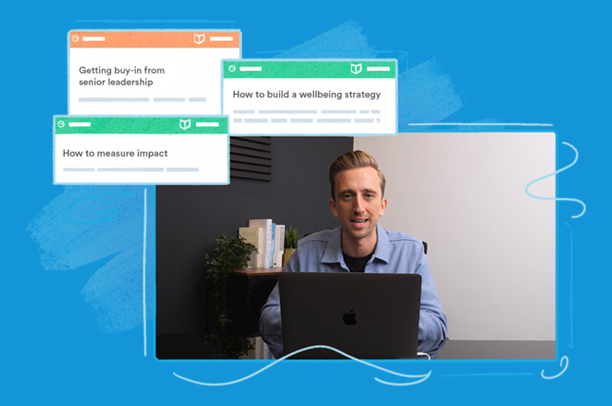When you think of mental health and well being what comes to mind? For many of us self-belief mantras, meditation and live improvement podcasts might be all we ever know for well being and therefore believe there is nothing there for us. However, times have changed and our minds are open to the simpler everyday moments that help build our mental health. Supporting the well being and mental health of your employees can offer a number of hidden benefits for both the individual and the business.
What Is Well Being and What Are The Benefits In The Workplace?
A peaceful mind gives us inner strength and self confidence which is important for good health.
Well being can often be described as the way in which we feel and how we function day to day. Well being means different things to different people, and the way in which we support our well being is dependent on internal and external variables in our lives.
There are a number of benefits in supporting well being at work ranging from increased confidence, self belief, better teamwork, increased productivity, stronger engagement and reduction in absenteeism and staff turnover.

How to Support Employee’s Well Being
Create a Supportive Environment
Support from an employer can be both professional and personal. The notion that ‘there is no sentiment in business’ runs true, however formal situations can cause us to feel nervous and afraid to open up about personal issues such as mental health.
At different times of our lives we experience a rollercoaster of emotions and while some of us can master challenges that life throws at us tackling negative self talk is the hardest hurdle to climb. If an employee feels they can speak candidly with their employer about their well being, mental ill health is less likely to arise and become problematic. By talking openly, you too as their employer are able to help them if it’s needed.
Using data from employee questionnaires on the Everymind app developing a supportive environment helps with a number of aspects such as reducing anxiety, an improved mood, stronger connections and solid self belief. Here are a number of ways you can support the well being of your employees.
How To Create a Supportive Environment
Raise Awareness
For employers to fully be able to support their staff they do need a certain amount of understanding and knowledge. Conversations around mental health can be difficult and oftentimes hard to relate to but as we all know talking with someone who has a basic understanding of where we’re coming from gives us the mental capacity and capability to open up. Raise awareness around your company by sending out internal newsletters, delivering messages on payslips or dotting information in the office and social areas.
Host Mental Health Days
Mental health days should be celebrated regularly and not just during Mental Health Awareness Week. You can actively encourage positive mental health through employee L&D opportunities or appoint ‘mental health champions’ that promote mental health awareness throughout the business. These champions can host seminars, well being events that creates an open environment around positive mental health.

Conduct Regular 1:1s
Regular one on one time between managers and employees outside of review periods and appraisals should be a priority. The idea is to give both the employee and the manager to speak organically about how they feel about the work they’re doing. Should any issues arise, the manager and employee can work together to resolve them.
Include Mental Health and Well Being Training in Your L&D strategy
It is believed that an estimated 15.4 million work days are lost to mental health in the UK. Therefore, businesses that promote healthy human beings within their workforce take the lead as stand out companies to work for. In doing so, compulsory and voluntary training should be taken into consideration every six months when it comes to the well being of your working community.
Proven to provide a number of benefits from reducing fear of failure as well as a reduction in anxiety and stress levels, a growth in skills and knowledge gives the employee an increased ability to look after themselves which indirectly contributes to their well being.
How to Implement Well Being Into Your L&D Strategy
Training courses allow for us to improve on areas of weakness and to grow professionally. Employees like to feel valued and heard, therefore by offering training courses employees are better able to manage stress, improve their sleep, understand their emotions and better prioritise self care in the form of mindfulness and meditation.
Invest in physical health by providing seminars on healthy eating and nutrition and the benefits of exercise. Nutritionists, psychologists and life coaches can all offer in depth lectures to employees on our mind body connection. What we put into our body and how we treat it physically plays a big part in how we feel and function mentally.

Support the financial well being of your employees by hosting training and webinars with financial planners and partners. At some stage in our lives we will all worry about our financial situation, whether it comes to putting a deposit on a house or having a baby. By supporting employee’s financial concerns, their stress levels will be reduced and their focus at work will improve.
Check Your Employee Benefits Support Mental Health
Mental health isn’t isolated to ill-health, we all have mental health in the same way we have physical health. Choosing the right benefits to support both employee engagement and mental well being not only lets your current employees know you value their mental health it also helps to attract top talent to your business.
How to Support Mental Health at Work
Health insurance is a fail-safe protection to offer all employees upon onboarding. Healthcare cash plans are also available as an option to businesses who want to support the welfare of their workforce. Not only does it allow for them to take better care of themselves you’re sure your team can work to the best of their ability.
Whilst many of us continue to work from home, we don’t need to work out from home. Today, many businesses have invested in on-site gyms and yoga classes as well as offering discounted gym and fitness memberships in the local area. Not only does this incentivise employees to look after their physical health it improves our mental well being day to day. Cycle-to-Work schemes are also a fantastic way to get employees moving their body that looks after the environment too.
Healthy office snacks should replace junk food and vending machines lending themselves to unhealthy snacking. Providing our bodies with nourishing wholesome foods helps reduce stress and anxiety and relaxes the mind.
Community outreach and giving back provides a nice anchor in boosting our self esteem and well being. Set up paid days for employees to take the day to volunteer for a charity with the local community by working with a food bank or homeless shelter. Its proven that businesses investing in the like have a happier workforce behind them.
Well being programs are a great solution to businesses unsure on how to inject well being in their work strategies. With a variety on the market to choose from, employer’s can benefit from yoga classes, weight rooms, family assistance, ski classes, training programs. The list really goes on but our advice would be to survey your workforce to determine what individuals value the most when it comes to their well being.
Lead A Work-Life Balance Example
When did being busy all the time become cool? As a nation we are increasingly surrounded by a demanding work culture, and in doing so we are neglecting areas of our lives that make us resilient to mental health problems. Chances are many of us have been burnt out at various stages of our lives and one of the ways to counteract this is ensure we have a healthy work-life balance. It not only gives us the time to focus on other meaningful aspects of our lives it gives us the space to relax and do the things we enjoy.
How To Promote Work-Life Balance In the Workplace
Flexible working allows us to prioritise the core basic principles of self-care because we have the mental capacity to do so. Chaotic professional lives seep in our social circles and with limited time and space to be present and patient we risk burnout, impatience and lack of focus.
Along with flexible working, encourage your teams to take regular breaks. Working solidly for eight hours becomes counterproductive on our focus and motivation. Short breaks throughout the day increases our blood flow and revitalises our minds.

Be a role model to your staff as a senior leader or HR manager that work-life balance is important to you too. If employees see their manager or seniors prioritising quality time with their families, in the gym or having downtime, they too will feel encouraged to do so.
Adopt the notion that PTO means PTO. Employees are all entitled to PTO each year that can be taken as and when they wish (that avoids busy periods), during this time they should not be disturbed about work matters. Whilst some businesses express overtime is oftentimes necessary, employees should not be expected to check emails or work on the weekends if it is not in their contract to do so.
Focus on productivity and outcomes, rather than hours. Being driven by performance is far more productive than insisting employees work a solid 38 hour week. You can ensure targets are being met by hosting regular meetings to review time frames and workload levels of employees. In these meetings employees can offer feedback about their needs whether they need flexibility in their work-life balance or whether they are a working parent.
Set Realistic Expectations
Many of us set ourselves goals throughout our life, these can be personal and professional and are often a good motivator to push us to what we want to achieve in life.
Targets, deadlines and KPIs in the workplace work in exactly the same way, from both an employer’s and employee’s perspective they aim to reach our full potential. If the goals you set are vague or unattainable they can increase feelings of self-doubt and anxiety. Whilst if an employee fails to achieve a set goal, they may also experience depression and anxiety.
That being said, achieving our goals gives us a sense of accomplishment and releases ‘feel good’ chemicals such as dopamine (the same feeling we have when we eat chocolate) which makes us feel more confident and happier.
It is therefore important to know how to set achievable goals and expectations to ensure they boost employee mental health not hinder it.
How to Set Realistic Expectations
Set SMART goals for employees. SMART goals must be: Specific, Measurable, Achievable, Relevant and Time-bound. This way they are within reach of the individual and work inline with their personal career goals too. Remember, employees work for you however they too have ambition of where they wish to be in life. Therefore, when setting these goals, make sure employees understand the targets they have been set and are comfortable with them.
So that both you and the employee understand the progress by conducting regular 1:1 meetings throughout the year and not solely during review periods or during an appraisal. This ensures employees get regular feedback, help and support to achieve their KPIs.
Zen Your Working Environment
Many businesses have favoured a home-based working environment in recent months, however if your business is office based it also contributes to the well being of your employees. By balancing the work settings of your employees they won’t feel as though they have been chained to their desks when the clock strikes 5pm.
Provide social areas within the office space, these can be used for informal meetings, brainstorming ideas or for employees to detach themselves from their desks to enjoy their lunch break. Remember we all work differently and whilst some employees prefer to have a set desk, others like to have a hot desk to work froma.
Ensure that your office ergonomics meet required standards. Office ergonomics are in place to help employees work comfortably and can reduce stress and injury caused by sitting in awkward positions and completing repetitive tasks.
Design features to consider in your working environment include the amount of natural lighting entering the working space. Natural light is far better for our bodies and functionality than artificial light, therefore, is there a way you can design the space to equip desks with natural light as opposed to the social areas?
Colours around us can affect our mood, for example blue and green evoke a sense of serenity and well being, whereas bright colours instill energy and alertness. Perhaps in various areas of the office you can combine the two to support different energies in the workplace. To inject more colour, hang some wall art around the office, it is believed that artwork has been shown to increase creativity and productivity in employees.
Being surrounded by nature increases our oxygen levels and brings a sense of serenity to our bodies. An increase in oxygen is a key pillar to support concentration and productivity and improves our overall mood. Bring plants and natural elements to your office to create a natural and calming environment.

We previously mentioned the benefits and impact of physical activity on our mental well being, with this in mind, do you have bike storage and changing facilities in your workspace? This alone can be a quick win for employees and encourages them to take care of their physical well being. Additionally, a games room with table tennis or pool table encourages employees to be more active throughout the day and help with focus when they return to work after.








